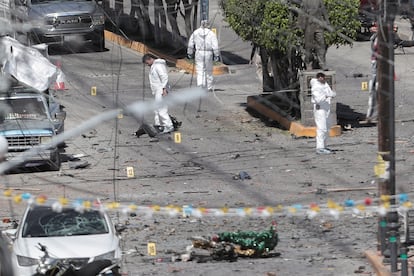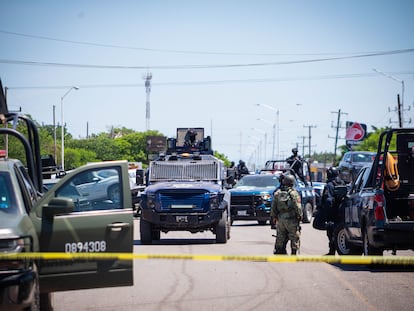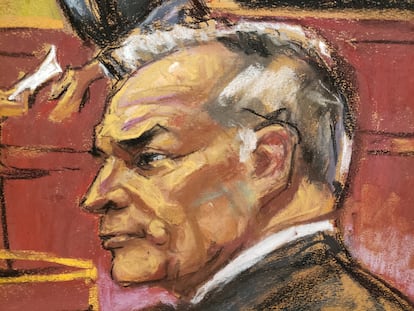Car bomb attacks signal escalation of cartel violence in Mexico
Guanajuato, the state with the highest homicide rate, saw two explosions in Acámbaro and Jerécuaro — a tactic that’s been used before in the spiral of violent crime affecting the region

Cartel violence is gripping Mexico. In the state of Guerrero, the mayor of Chilpancingo was decapitated. In Sinaloa, a truck was discovered with at least five bodies along with the ominous message “Welcome to Culiacán.” And now Guanajuato has been shaken by two explosions.
Police in the city of Acámbaro reported a car bomb attack outside their offices, resulting in at least three officers injured, seven vehicles burned, and extensive property damage early Thursday morning. Just hours earlier, in the city of Jerécuaro, located just 20 miles away, another attack was reported: a car exploded and several others were set on fire, including a patrol car. No deaths were reported.
Guanajuato is the Mexican state with the highest number of intentional homicides, with 1,863 open murder investigations this year, according to official data. The state is grappling to understand these brutal events, as no criminal organization has claimed responsibility. The new governor, who took office less than a month ago, is seeking answers.
“The events that occurred in Acámbaro and Jerécuaro will not stop our efforts to restore peace to Guanajuato,” said Libia Dennise García Muñoz Ledo, who was inaugurated as state governor on September 26. In response to the violence, she announced a coordinated land and air operation to apprehend those responsible, and suspended her public agenda to address the emergency.
Politics and narcoterrorism?
“This new wave is a result of changes in the government,” says analyst David Saucedo, who attributes the attacks to the onset of a new political cycle. He argues that the reshuffling within the state government has led to an “attitude of resignation” among outgoing officials, coinciding with criminal groups’ intent to send a “strong message” to incoming leaders.
“The criminal organizations in the area are trying to dominate local governments, and if there is any resistance or opposition, they will resort to acts of narcoterrorism to undermine their credibility in public opinion,” he explains. Saucedo firmly believes that the attacks fall within the realm of narcoterrorism, as they aim to instill fear in the population and compel authorities to submit to organized crime.
However, other experts are hesitant to classify the explosions in Jerécuaro and Acámbaro as acts of terrorism. The classic definition of terrorism involves using violence to achieve political or religious objectives. Víctor Hernández, a researcher at the Tec de Monterrey University, argues that this definition may not apply in this case, as the intent behind the attacks remains unclear. “If the Sinaloa Cartel or the Jalisco Cartel were attempting to take control of the Mexican state and replace it, we could discuss narcoterrorism. The reality is that organized crime is primarily interested in having the government in its pocket,” he contends.
This debate extends beyond academic circles; during the U.S. election campaign, ultra-conservative factions of the Republican Party, along with those close to Donald Trump, are advocating for cartels to be classified as terrorist organizations to justify U.S. military interventions in Mexico. “We must be cautious with labels,” warns Saucedo. The discussion has also infiltrated Mexican politics: while the National Action Party (PAN) and the Institutional Revolutionary Party (PRI) have called these attacks and others as “acts of terrorism,” the left-wing Morena party tends to downplay the incidents of violence, accusing the media and opposition of “exaggerating.”
The war in Guanajuato
The fracture within the Sinaloa Cartel has drawn significant media attention during the final stretch of the Andrés Manuel López Obrador administration and the beginning of the Sheinbaum government. However, official figures updated at the end of September reveal that Guanajuato has experienced more than double the number of homicides compared to Sinaloa in 2024. The ongoing conflict between the Santa Rosa de Lima Cartel and the Jalisco Nueva Generación Cartel has unleashed a wave of violence across the state. In the past week alone, three women were shot in Celaya, human remains were discovered in Yuriria, a shooting in Acámbaro left six wounded, and an intentional fire broke out at the Villagrán garbage dump.
Analyst David Saucedo hypothesizes that the Santa Rosa de Lima Cartel is behind these attacks, as both municipalities are considered areas of influence for that group, and the modus operandi aligns with their tactics. “Explosives are their hallmark,” he explains.
In January 2019, at the start of López Obrador’s offensive against huachicol (fuel theft), the cartel abandoned a van laden with explosives outside a refinery in the city of Salamanca, which was later deactivated. In 2020, there were further warnings, including a car bomb left outside the refinery that failed to detonate and another explosion outside a National Guard base in Celaya that resulted in no injuries.
In 2021, two individuals delivered a “gift bomb” to restaurant owners in Salamanca, resulting in two deaths and five injuries. In 2022, two police officers were ambushed with remote-controlled explosives in Irapuato, and in June of last year, 10 National Guard agents were injured in a car bomb explosion in a rural community in Celaya. The attacks in Jerécuaro and Acámbaro were not isolated incidents.
In the absence of an official account of the recent attacks, Saucedo notes that explosives are typically employed by Santa Rosa de Lima to demand payment for protection money, weaken the operational capacity of security forces, divert attention from authorities, or to assert control. “There is no other criminal group in the region that has the capacity, expertise, or history in handling explosives,” he concludes.
Conversely, analyst Víctor Hernández suggests that the tactical use of explosives may point to the Jalisco Cartel, describing it as “a violent, bloodthirsty, and predatory cartel of the local economy.” Authorities have yet to release initial findings from their investigations. It is also possible that each group may attempt to incriminate its rivals to draw law enforcement attention. Guanajuato remains a battleground rife with uncertainty.
Bombs, grenades and drones
The use of bombs and drones has also spread to other violent hotspots across Mexico. In Michoacán, the Jalisco Cartel has been reported to employ antipersonnel mines in rural areas, and just two weeks ago, there was a bomb threat at a shopping center in Morelia, the state capital. Last week, a homemade bomb was deactivated in Sinaloa amid ongoing disputes between Los Mayos and Los Chapitos. At the end of last year, the Ministry of National Defense reported the seizure of 33 drones in eight different states since 2019, with more than half recovered in Michoacán, followed closely by Guanajuato.
Hernández points out that the Sinaloa Cartel has formed pragmatic alliances with the Santa Rosa de Lima Cartel to launch incursions into Guanajuato and combat their common enemy, the Jalisco Cartel. He compares incidents like the drone attack in Tepalcatepec, Michoacán, to scenes witnessed during the invasion of Ukraine. Two months ago, three drug factories producing homemade and artisanal explosives were discovered in Michoacán, along with several mortars. Perhaps the most notorious precedent for such an attack on civilians occurred 16 years ago during the Independence Day celebrations in Morelia, where at least eight people died from a coordinated grenade assault. No group claimed responsibility for the attack.
José Antonio Yépez Ortiz, known as “El Marro,” was arrested in August 2020 after six years leading the Santa Rosa de Lima Cartel, marking one of the most publicized victories of López Obrador’s administration against organized crime. But Hernández says that while authorities promised that the arrest would put an end to the violence, this has not happened, arguing the situation in Guanajuato is an example of how the strategy of arresting high-profile leaders has failed.
“They do not reduce violence; in fact, they often exacerbate it in the medium term,” he says. Regarding the recent attacks, he adds: “While it is complex and requires technical skill to assemble a car bomb, it did not have the capability to destroy the police station or cause a massacre. It has more of a psychological impact than a real one.”
Saucedo is also skeptical about the effectiveness of the government’s strategy against crime, questioning whether there will truly be a shift under the leadership of Guanajuato’s first female governor and Mexico’s first female president. “The narrative of drug trafficking is more powerful than the government narrative. We only see plans and ideas from the authorities, while drug traffickers fight with blood and fire,” he concludes.
Sign up for our weekly newsletter to get more English-language news coverage from EL PAÍS USA Edition
Tu suscripción se está usando en otro dispositivo
¿Quieres añadir otro usuario a tu suscripción?
Si continúas leyendo en este dispositivo, no se podrá leer en el otro.
FlechaTu suscripción se está usando en otro dispositivo y solo puedes acceder a EL PAÍS desde un dispositivo a la vez.
Si quieres compartir tu cuenta, cambia tu suscripción a la modalidad Premium, así podrás añadir otro usuario. Cada uno accederá con su propia cuenta de email, lo que os permitirá personalizar vuestra experiencia en EL PAÍS.
¿Tienes una suscripción de empresa? Accede aquí para contratar más cuentas.
En el caso de no saber quién está usando tu cuenta, te recomendamos cambiar tu contraseña aquí.
Si decides continuar compartiendo tu cuenta, este mensaje se mostrará en tu dispositivo y en el de la otra persona que está usando tu cuenta de forma indefinida, afectando a tu experiencia de lectura. Puedes consultar aquí los términos y condiciones de la suscripción digital.
More information
Archived In
Últimas noticias
‘How does it feel to be a failure?’: Elizabeth Berkley’s journey from ‘Showgirls’ ridicule to vindication
The story of the Málaga virus: The code that haunted Google’s cybersecurity center director for 30 years
The impact of Ecuador’s mega-prison: A polluted river, cleared forests and military checkpoints
Corinne Low: ‘I’m more concerned about the female happiness gap than the gender wage gap’
Most viewed
- The low-cost creative revolution: How technology is making art accessible to everyone
- Christian Louboutin: ‘Young people don’t want to be like their parents. And if their parents wear sneakers, they’re going to look for something else’
- All the effects of gentrification in one corner of Mexico’s Colonia Roma
- Liset Menéndez de la Prida, neuroscientist: ‘It’s not normal to constantly seek pleasure; it’s important to be bored, to be calm’
- December Social Security and SSI payments: Dates, double checks and the 2026 COLA increase











































